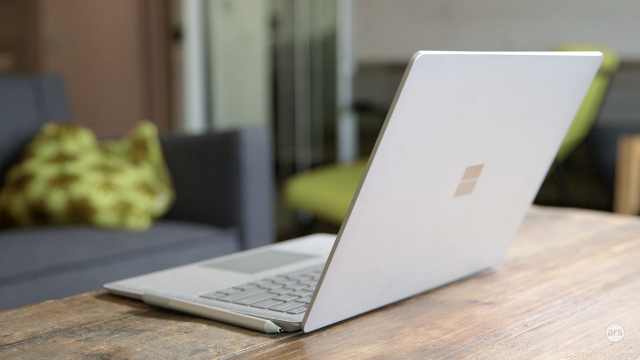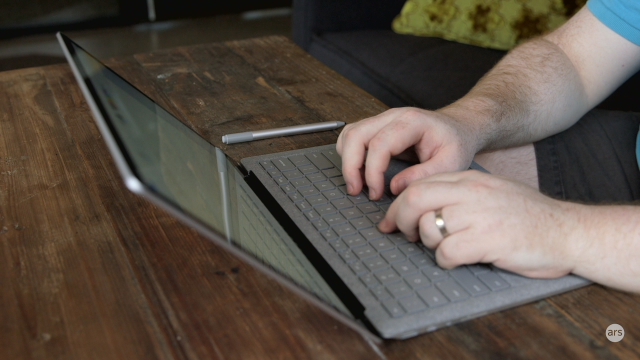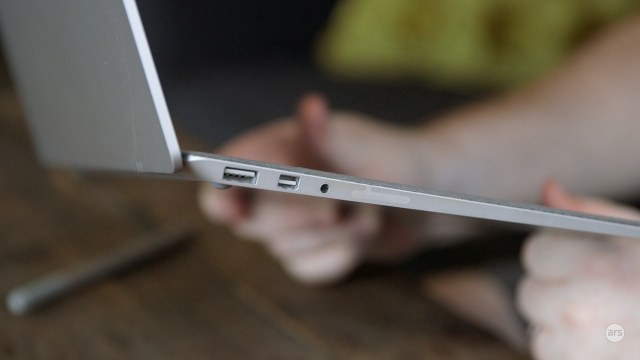After several years of building systems that compete with, but aren't quite, laptops, Microsoft has built a plain old laptop: the Surface Laptop.
I think there's a good chance that the Surface Laptop will become Microsoft's best-selling piece of PC hardware. This is such a straightforward proposition: it's a regular PC laptop. It has no trickery; no tear-off keyboard, no special hinge, no detachable GPU, none of the other things that have made the Surface Pro, Surface Book, and Surface Studio notable or unusual. It can't be said any plainer: Surface Laptop is just a PC laptop.
This makes Microsoft's latest offering an easier sell than the other Surface hardware. Potential buyers don't need to learn and understand how a new kind of device will fit into their lives, because they already know how they use laptops. As such, I expect sales will be vigorous.
There's a flip side to this, of course. Surface Laptop is also the least compelling, least interesting piece of hardware Microsoft has put out—to such an extent that I'm baffled by the process that went into its creation. Surface Laptop does not advance the state of PC hardware; it does not explore new form factors or designs; it does not serve as a showcase for Windows 10.
Surface Laptop is singularly unambitious. I'd call it conservative, but I think even that is too generous. Companies like HP, Dell, and Lenovo are doing more to make PC hardware better, to make Windows 10 better, and to embrace new technology than Microsoft is doing with Surface Laptop. Surface Laptop is a brand new machine, and yet in a number of ways, I feel it has already been left behind by the rest of the market.
| Specs at a glance: Microsoft Surface Laptop (2017, 1st-gen) | |||
|---|---|---|---|
| Base | Best | As reviewed | |
| Screen | 2256×1504 13.5" (201 PPI), 10-point capacitive PixelSense touchscreen | ||
| OS | Windows 10 S (with free upgrade option to Pro) | ||
| CPU | Intel 7th generation Core i5-7200U | Intel 7th generation Core i7-7660U | Intel 7th generation Core i5-7200U |
| RAM | 4GB | 16GB | 8GB |
| GPU | Intel HD Graphics 620 | Intel Iris Plus Graphics 640 | Intel HD Graphics 620 |
| SSD | 128GB | 512GB | 256GB |
| Networking | 802.11ac/a/b/g/n with 2x2 MIMO antennas, Bluetooth 4.0 | ||
| Ports | Mini-DisplayPort, headset, USB 3.0, Surface Connect | ||
| Cameras | 720p video, infrared facial recognition | ||
| Size | 12.13×8.79×0.57" (308×223×14mm) | ||
| Weight | 2.76 lb (1.25 kg) | 2.83 lb (1.28 kg) | 2.76 lb (1.25 kg) |
| Battery | 45Wh | ||
| Warranty | 1 year | ||
| Price | $999 | $2,199 | $1,299 |
A better MacBook Air
If we accept that Surface Laptop is not even remotely attempting to advance the state of the art, the system is a competent entrant into the laptop space. The hardware is attractive, blending design cues from previous Surface systems—the lid looks almost identical to that of the Surface Book, with its square edges, rounded corners, and shiny version of the Microsoft logo—with some elements to make it a better laptop. The base portion isn't all parallel lines and flat faces. There are angles, tapers, and chamfers.
The system I was sent to review was in the standard platinum color. Every configuration is available in this color, but one system spec—i5 processor, 8GB RAM, 256GB storage—is also available in Burgundy, Cobalt Blue, and Graphite Gold. Later this year, a second spec (i7 processor, 16GB RAM, 512GB storage) will also be available in those colors. But right now, those systems are only available in platinum.

The Surface Laptop shows its Surface pedigree. The screen has a rather peculiar resolution—2256×1504 with a 13.5-inch diagonal—but it has Surface's now familiar 3:2 aspect ratio, ten-finger touch, and pen support (if you buy the $99 Surface Pen). It's bright and crisp and a pleasure to use. The screen also includes a 720p camera with Windows Hello facial recognition support. This has been well optimized in the Surface Laptop. The time taken to wake from sleep and turn on the camera has been streamlined so that there's no delay between opening the lid and logging in with your face.
The keyboard is a close sibling, perhaps even identical, to the ones in the latest Type Covers, and it's none the worse for this. Key travel is respectable, the key action is very crisp, and it's easy and precise to type on. The touchpad also has the usual Surface characteristics: smooth glass surface, respectable size, and good precision and accurate detection of the Precision Touchpad gestures.
Colors aside, the one novelty of the Surface Laptop is the keyboard surround. Rather than bare metal or some kind of composite, Microsoft has covered it with Alcantara, a synthetic fabric. Microsoft has used Alcantara for keyboard surrounds before, as most of the new Surface Pro keyboards use it, for example. Alcantara is more commonly used in a range of automotive applications, such as to cover steering wheels. It's designed to be hard-wearing and tolerant of the sweat and grime that are features of this kind of use.
There's a chance that in three or four years I'll be proven wrong, but today the fabric strikes me as an entirely inappropriate choice for lining a laptop's interior. I've seen many disgusting-looking Alcantara Type Covers for Surface Pro 4, and after regular usage, they just get dirty and grimy and are impossible to clean. The Alcantara used in the Surface Laptop is supposed to be better—more resistant to dirt, easier to wipe down—but I simply don't buy it. Microsoft is positioning these systems as being perfect for a college kid to use for the duration of their four-year degree. Four years of eating at your computer, hands covered in Dorito debris as you're baked out of your mind (because hey, that's what college is all about). Four years of spilled drinks. Four years of sweating because it's summer and your AC is busted. Four years of browsing all of the Internet's multimedia delights. I just can't see these systems remaining clean and hygienic over those four years.

Still, the decision to use Alcantara is not entirely without its merits. Instead of the wrist-cutting hard metal edges that are common to so many laptops these days, the Alcantara is soft and comfortable. You can rest your forearms on the Laptop without discomfort. This is a good thing, but I feel that there are ways to achieve the same effect that don't require the use of a fabric interior. Dell uses a rubbery soft-touch paint, for example.
Internally, the Surface Laptop uses 7th generation Kaby Lake Intel Core processors. The i7 version includes Iris Plus graphics, so it should be faster than its mere clock speed would indicate thanks to the embedded memory on the processor. RAM starts at 4GB, which is frankly ludicrous in this day and age, though most models have a more reasonable 8GB or 16GB. Storage options are 128, 256, or 512GB of PCIe SSD. Surface Laptop performs in line with comparable Kaby Lake systems. Battery life is middle-of-the-road. Pricing, from $999 for the 4GB/128GB/i5 model up to $2,199 for 16GB/512GB/i7, is premium but roughly in the right ballpark.
Notably, the Surface Laptop also comes with Windows 10 S, the new version of Windows 10 that only runs apps from the Windows Store. The principle is that this should make for a more consistent, more reliable, more secure Windows 10 experience.
While I don't think that Windows 10 S is perfect, I do broadly agree with the ideas behind it and support it in principle. But the reality is, the Windows Store does not have all the software I use or need, so I had to take advantage of the free upgrade to Windows 10 Pro. I think most people buying the Surface Laptop will have a similar experience. Even with Office and, later this year, iTunes in the Store, it's still too limiting a constraint.
But it's not 2012 any more
So... slim, good looks, good weight at a little under 3lbs, good keyboard, good touchpad, good screen. Why am I so down on Surface Laptop?
If Microsoft had released this thing back in 2012, back when it launched the original Surface RT, it would've been a fantastic laptop. PC laptops weren't very good then. They tended to be ugly, badly built, laden with crapware. Little thought or care seemed to go into their design and construction. The occasional good machine could still be found, but by and large, if you wanted a great portable computer around that time, you had to buy one with an Apple logo on the lid.
Against that backdrop, Surface Laptop would have been a breath of fresh air; a way of showing that laptops could look good, have good input and output, and have long battery life. Microsoft would have unveiled a better MacBook Air.
But the PC OEMs have stepped up their game since then, and the MacBook Air is no longer the platonic ideal of what an ultraportable laptop should be. Most notably, Dell and HP have both realized that there's a market for good machines, and systems like Dell's XPS 13 and HP's Spectre range are well made, attractive, and desirable. Mercifully, it's not 2012 any more for computer buyers. Nailing the basics—screen, keyboard, touchpad, battery life, size, and weight—is no longer enough to make a system a good laptop. Today, that stuff is just table stakes. You have to go above and beyond to stand out.
The Surface Laptop doesn't really do this. Take its connectivity, for example. Surface Laptop disappointingly takes after the new Surface Pro: it has a single USB 3.1 generation 1 (5 Gbit/s) Type-A port, a mini-DisplayPort port, a headset jack, and the proprietary Surface Connect port used for both charging and to connect Microsoft's Dock. That is to say, there is no USB Type-C and no Thunderbolt 3 on a machine that, let's not forget, Microsoft reckons will be useful for at least four years.

There's no shortage of room on the Surface Laptop. Doing a good implementation of Thunderbolt 3 and USB Type-C isn't trivial; there's engineering work to do to ensure that desirable properties, such as charging using any Type-C port, are implemented properly. But the challenge is not insurmountable. Other PC manufacturers are doing it. Why isn't Microsoft? Yes, Type-C and Thunderbolt 3 are still in their relative infancy. There isn't an abundance of devices out there, but there are interesting applications for Thunderbolt 3—single cable connectivity to monitors delivering both picture to the monitor and charging power back to the laptop, docking stations, and external GPUs. It's likely that Thunderbolt 3 devices will only grow more widespread over this system's four-year lifetime.
Similarly, while on the one hand PC OEMs are concerned about the user experience if a laptop is accidentally charged from a smartphone charger—something made possible by USB Type-C—I feel this concern is misplaced. It's true that the laptop will charge much more slowly from a 5W smartphone charger than a 35 or 60W laptop charger. It may not even be able to charge at all unless sleeping, merely treading water draining its battery as fast as it charges while turned on. But you know what? It'll still charge faster from a 5W smartphone charger than it will from no charger at all because you've left it on your desk at work. A world in which every laptop's charger is compatible, and where you can use a phone charger at a pinch, is a world I want to live in.
Certainly, it would be great if manufacturers could come up with, say, a clear labelling system indicating the output power of their chargers. Windows could probably be a little more informative about any slow charging situations, too. But Type-C represents opportunity and an improved user experience if done thoughtfully and carefully. Other companies are already doing this well, but Microsoft isn't even trying.
reader comments
192